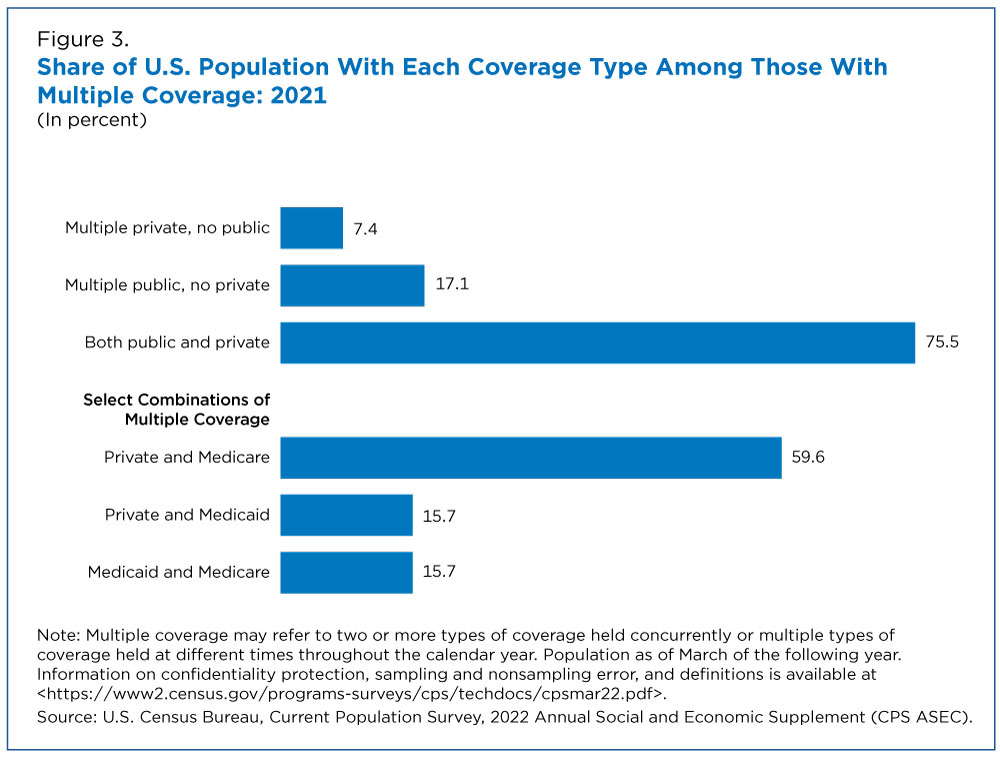People Ages 65 and Older Were Most Likely to Hold More Than One Health Insurance Plan
While the majority of people in the United States have private health insurance — primarily through an employer — many others have coverage through programs offered by the government or no coverage at all.
But a large number of mostly older individuals have more than one plan, according to a recent report that provides estimates of health insurance coverage in 2021. Single service plans, such as vision, dental or prescription drug, are not considered comprehensive and are not counted as health insurance coverage.
Individuals with multiple coverage include anyone who was enrolled in more than one plan at the same time in 2021. For example, some low-income people with a disability may qualify for both Medicaid and Medicare coverage if they meet eligibility requirements. Others may hold multiple coverage because they change their type of health insurance plan over the course of the year.
Adults 65 years and older were the age group most likely to be covered by more than one plan because many supplemented Medicare coverage with privately purchased plans or coverage through a current or previous employer.
The 2022 Current Population Survey Annual Social and Economic Supplement (CPS ASEC) shows that in 2021, most people (78.6%) had only one type of health coverage for the entire calendar year and 8.3% had no coverage at all. That leaves about 43.1 million people (13.1%) with more than one type of health insurance coverage (Figure 1).
Who Holds Multiple Coverage?
Adults 65 years and older were the age group most likely to be covered by more than one plan because many supplemented Medicare coverage with privately purchased plans or coverage through a current or previous employer.
In 2021, about 29.2 million people with multiple coverage were 65 or older, representing more than half (51.9%) of adults in this age group. In contrast, about 5.5% of adults ages 19 to 64 and 4.1% of individuals under age 19 had more than one type of health coverage (Figure 2).
The likelihood of having multiple coverage also varied by income. Family resources may determine the ability to afford private health insurance and families below certain income-to-poverty thresholds may qualify for public health insurance options.
People are classified as being in poverty if their family income is less than 100% of the poverty threshold. Family resources are classified by the ratio of family earnings to the poverty threshold. In 2021, the poverty threshold for a family with two adults and two children was $27,479.
About 13.7% of people with incomes between 100% and 399% of their poverty threshold had more than one type of coverage in 2021, followed by 12.9% of those with incomes at or above 400% of the federal poverty level and 12.1% of those in poverty.
In 2021, working-age adults between ages 15 and 64 with a disability (17.1%) were more likely than those without a disability (4.3%) to have more than one type of coverage. People with a disability may be eligible for dual coverage through Medicaid and Medicare, which may help explain this difference.
Types of Multiple Coverage
Most individuals (75.5%) with more than one type of coverage in 2021 had both private and public coverage.
About 25.7 million people (59.6% of those with multiple coverage) had both Medicare and some type of private coverage, reflecting the high percentage of multiple coverage holders age 65 and older.
About 6.8 million (15.7%) multiple coverage holders had Medicaid and private coverage and another 15.7% were covered by both Medicaid and Medicare (Figure 3).
Note: More information on confidentiality protection, sampling and nonsampling errors and definitions is available in the technical documentation. All comparative statements in this story have undergone statistical testing and, unless otherwise noted, all comparisons are statistically significant at the 10% significance level.
Related Statistics
Subscribe
Our email newsletter is sent out on the day we publish a story. Get an alert directly in your inbox to read, share and blog about our newest stories.
Contact our Public Information Office for media inquiries or interviews.
-
America Counts StoryUninsured Rate Declined in 28 States 2019-2021September 15, 2022Today’s release of the 2021 American Community Survey 1-year estimates shows increase in public health coverage in 36 states.
-
America Counts StoryMore Education Does Not Erase Racial Disparities in Health CoverageMarch 08, 2023Adults with a high school education or less have higher uninsured rates than those more educated. Racial/ethnic inequalities exist even among the more educated.
-
America Counts StoryWho Had Medical Debt in the United States?April 07, 2021Detailed tables from the Census Bureau’s Survey of Income and Program Participation provide a snapshot of households more likely to have medical debt in 2017.
-
EmploymentThe Stories Behind Census Numbers in 2025December 22, 2025A year-end review of America Counts stories on everything from families and housing to business and income.
-
Families and Living ArrangementsMore First-Time Moms Live With an Unmarried PartnerDecember 16, 2025About a quarter of all first-time mothers were cohabiting at the time of childbirth in the early 2020s. College-educated moms were more likely to be married.
-
Business and EconomyState Governments Parlay Sports Betting Into Tax WindfallDecember 10, 2025Total state-level sports betting tax revenues has increased 382% since the third quarter of 2021, when data collection began.
-
EmploymentU.S. Workforce is Aging, Especially in Some FirmsDecember 02, 2025Firms in sectors like utilities and manufacturing and states like Maine are more likely to have a high share of workers over age 55.







